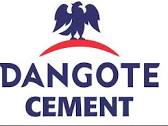
Nigeria’s cement companies are going through a rough patch despite rising market product prices. Rising input and logistics costs and falling exchange rates have made cement-making difficult. A senior executive of one of the big three product manufacturers who requested anonymity said, ‘We understand the social sensitivity of cement, but to ensure sustainability, we must align pricing with costs. We must find that balance between customer affordability and production sustainability. In the last two years, margins have fallen steadily despite price increases; the margin squeeze comes from costs rising faster than revenues’. But he laments, ‘We still come off as villains whether margins go up or down’.
Nevertheless, for good or bad, the Nigerian economy is adapting to a series of policy adjustments implemented by the new administration in 2023. The decision to adopt a floating exchange rate for the naira and remove petrol subsidies has led to currency depreciation, raising business operational expenses. As a result, inflationary pressures have intensified, affecting consumer prices and market demand.
In 2023, Dangote Cement was exposed to currency fluctuations across African economies, with Nigeria being the most affected. The Nigerian Naira experienced a significant depreciation of 51.6% against the US Dollar, while the Zimbabwe Kwacha similarly depreciated by 29.7% against the Dollar. However, amidst these depreciations, the FCFA (XAF) stood out with a modest appreciation of +3.5%. These currency movements introduced high exchange rate volatility, affecting the cost of imports, creating disruptions in trade balances, and contributing to higher levels of economic uncertainty and inflation (See Illustration below)
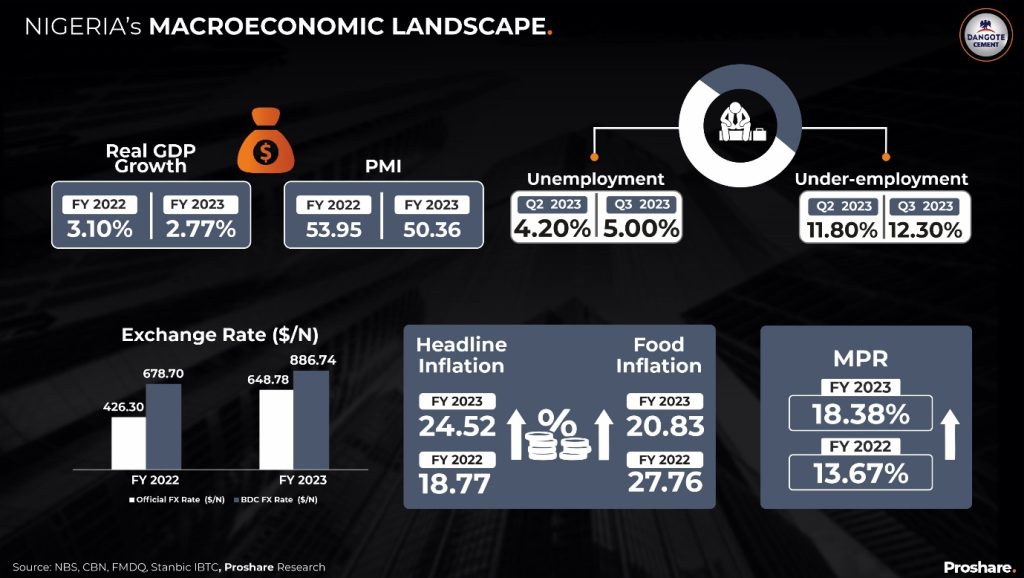
Dangote cement’s total sales and administrative expenses rose by 31.1% to N491.6bn in FY 2023, driven by the 27.6% increase in haulage expenses due to the significant rise in coat of AGO, coal and other materials. The total production cost of sales also increased by 51.8% to N1.006trn in 2023 from N662.9bn in FY 2022, owing to an increase in fuel and power consumed, which increased by 49.80% to N399.2bn; depreciation and amortisation increased by 34.99%, and other production cost increased by 126.77%.
Group earnings before interest, tax, depreciation, and amortisation (EBITDA) for the year increased by 25.1% to N886.1bn at a margin of 40.1% from N708.2bn in 2022. Pan-African EBITDA grew four times larger to N263.7bn in FY 2023, at a record margin of 28.5% from N64.9bn in 2022; this growth was supported by solid volume growth and a reduction in cash cost in some countries of operation.
Board of Directors
Auditors
KPMG Professional Services
Investor Indicators
- Market Capitalization 11.70trn
- Recent Price ₦618.10
- P/E (12-month trailing) 9.86X
- P/S 5.29X
- EPS (2023) N26.47
- Div Yield 4.37%
- Payout ratio 1.13X
Key Highlights
- The Cement maker’s revenue rose by +36.44% to N2.201trn in FY 2023 from N1.61trn, mainly due to improved price realisation in an inflationary environment.
- The cement company’s profit climbed, with Pre-tax and Post-tax profits rising by +5.55% and +19.17% to N553.10m and N455.58m, respectively, in FY 2023.
- The group’s total assets grew by +50.58% to N3.93bn in FY 2023 from N2.61bn in FY 2022.
- Total borrowings increased by +23.27% to N521.28m in FY 2023 from N422.891m in FY 2022.
- Inventories rose by +64.48% to N394.02m in FY 2023 from N239.6m in FY 2022.
- Group EBITDA up 25.1%; with a margin of 40.1% to N886.12bn in FY 2023N from N708.23bn in FY 2022.
- FX loss was up by 204.25% to N164.1bn in FY 2023 from N53.92bn in FY 2022.
- Interest expense and foreign exchange drove finance costs higher by 138.52% to N310.96bn in FY 2023, while finance income declined by -29.21% to N27.20bn.
- Cash and cash equivalents improved by +57.52% to N447.09bn in FY 2023 from N5283.84bn in FY 2022.
- Earnings per share was up by 18.8% to N26.47k in FY 2023 from N22.27k in FY 2022.
Operational Highlights
- The Group commissioned ten alternative fuel projects across its operations.
- The cement company commenced operations at the 0.45Mta grinding plant in Ghana.
- The group also commissioned a CNG station in Tanzania
- Dangote cement continued clinker exports from Nigeria and Congo to grinding plants in West Africa.
Revenue
Dangote Cement’s revenue from its Pan-African operations grew in 2023, more than doubling its 2022 figures. The growth rate rose by +123.2%, to N925.93bn from N414.83bn in 2022. The increase was driven by volume growth in Senegal, Congo, and Zambia. Sales volume across the four Pan-African operations grew substantially, climbing by +12.7% to 11.25Mt in FY 2023 from 9.98Mt in FY 2022.
The Nigeria operation experienced a slight growth of +7.7% to N1.297trn on price increases, while the sales volume from the Nigeria operation, which is cement and clickers, stood at 16.4Mt in 2023, down by -8.1% from 17.8Mt in 2022 (See chart one below)
Chart 1:
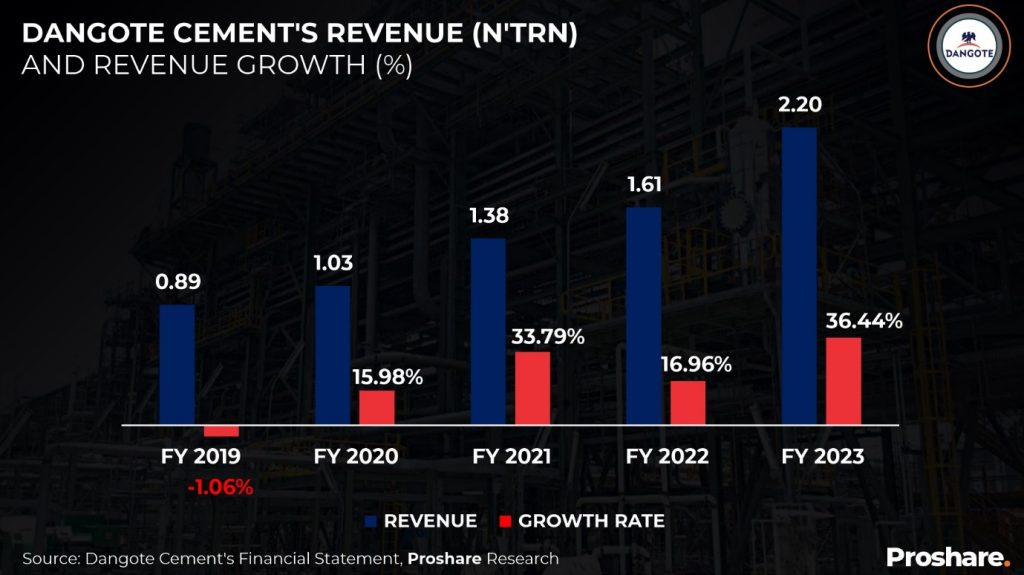
Profitability
Despite facing various expenses such as production, administrative, and selling/distribution expenses, the company increased its profit before tax (PBT) to N553.10bn in FY 2023 from N524.002bn in FY 2022, reflecting a growth of 5.55%. The cement company managed its income tax expenses, resulting in an increase of 19.17% in profit after tax (PAT) from N455.58bn to N382.311bn. Due to higher non-taxed exchange gain in the period, the effective tax rate increased to 17.6% in FY 2023 from 27.0% in FY 2022. Moreover, gains from the net monetary position and contributions from a share of profit from associates also contributed positively to the bottom line. (See chart two below)
Chart 2:
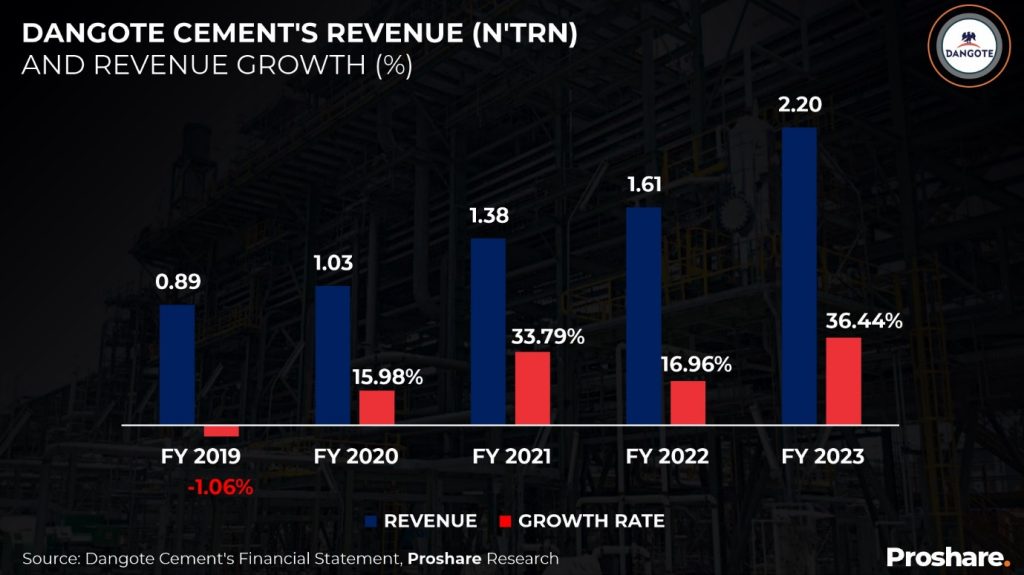
Financial Position
Dangote Cement’s financial position improved from FY 2022 to FY 2023, with its total assets increasing by +50.58% from N2.62trn in FY 2022 to N3.94trn in FY 2023. This was driven by growth in the group’s liquidity position, such as a +57.52% growth in cash and cash equivalents, +117.91% growth in right-of-use assets, and a +60.95% rise in trade and other receivables. On the other hand, liabilities arising from financing activities have increased by 23.81% to N521.3bn due to the 707.80% increase in (three-to-twelve-month loan repayment). Moreover, the group’s retained earnings increased in FY 2023, rising to N1.09trn as the net income of N455.58bn exceeds the dividend payout of N338bn (See Table 1 below).
Table 1:

Cash Flow
The Cement maker improved its cash flow performance from FY 2022 to FY 2023. The company saw a rise in net cash generated from operating activities, growing by +305.73% from N5.06bn in FY 2022 to N20.53bn in FY 2023. Despite a modest rise of 4.71% in net cash flows from investing activities, the company maintained a strong cash position, with cash and cash equivalents increasing by +97.16% from N5.71bn to N11.26bn. However, net cash generated from financing activities witnessed a slight decline of -17.45%, indicating a reduction in cash inflows from financing sources (See Table 2 below)
Table 2:
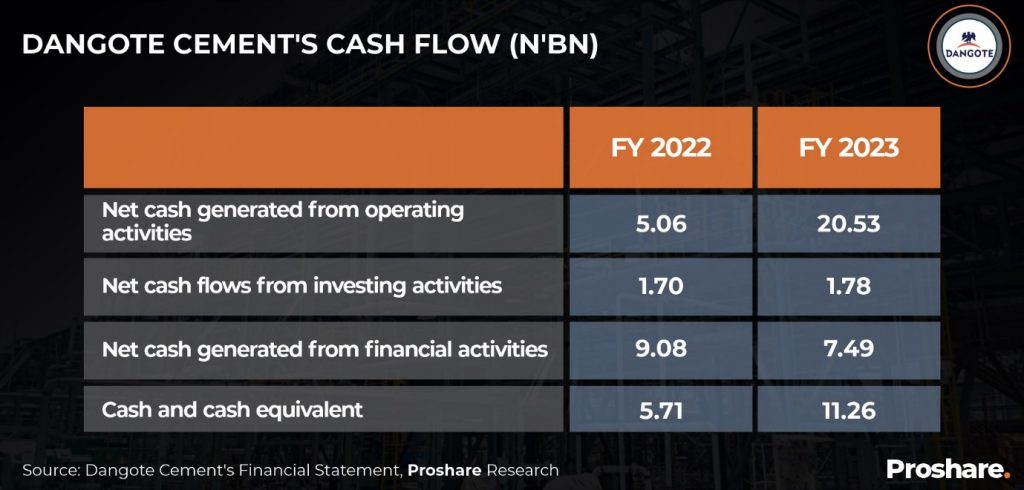
Ratios
Dangote Cement’s financial ratios for FY 2022 and FY 2023 show mixed performances. The leverage ratio fell from 0.39% in FY 2022 to 0.39% in FY 2023, suggesting reduced reliance on debt financing. However, the liquidity ratio tumbled to 0.87% from 1.00% in FY 2022 due to a +57.84% increase in current liabilities (driven by…) compared to liquid assets.
Return on Asset (ROA) and Equity (ROE) fell, indicating lower profitability. The cement maker’s net profit margin dropped to 20.63% in FY 2023 from 23.62% in FY 2022 as the rise in operating expenses cut into profit (See Table 3 below)
Table 3:
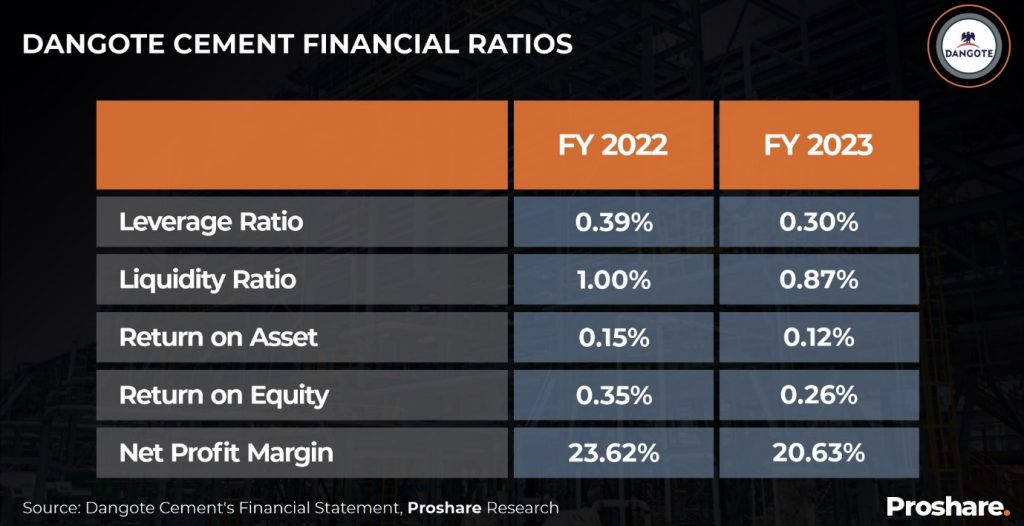
Share Price Movement
Dangote’s share price movement saw reduced volatility with occasional blips. Starting from January 3, 2023, the price hovered around the N260 to N270 range until late February. From mid-July, the stock’s price stayed at N352 for about two weeks before falling back to N320 in early August. The company’s price recovered and saw a spike in early September, rising to N370 before anchoring at N365.
The stock slipped in late September and early October, falling from N365 to N310.1. There was a slight rebound to N328 by the end of October. The share price saw several flat trading channels, such as in March, April, May, July, October, November, and December (See chart three below).
Chart 3:
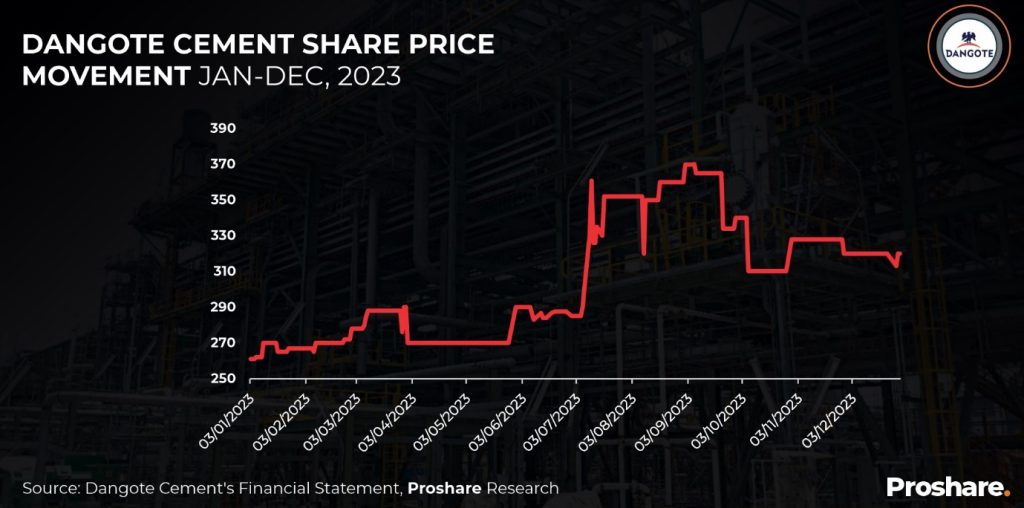
Competitor Analysis: Rising Expenses Hurt Margins
The cash crunch, energy shortage, FX scarcity, and reduced consumer disposable income affected the cement industry’s performance in 2023. However, the country’s high reliance on cement for housing and road construction supported demand despite the harsh macroeconomic environment, aiding revenue growth for the trio of dominant cement players.
Dangote Cement had the highest revenue growth at 36% at N2.21trn, followed by BUA Cement at 27% to N460.00bn, and Lafarge at 9% to N405.50bn. Despite the increased cost of sales, the cement companies earned a higher gross profit margin, with Dangote Cement leading at 54%, followed by Lafarge Cement at 51%, and BUA Cement at 40%. Given the swollen operating costs incurred, the net profit margin slipped across the companies, with Dangote Cement leading at 21%, BUA Cement at 15%, and Lafarge Cement at 13%. During the period, the 50%-naira devaluation resulted in significant FX revaluation losses, putting pressure on profit; Dangote Cement had the highest at N164.08bn, followed by BUA cement at N69.96bn, and Lafarge had the lowest at N21.04bn.
Based on cash positions, Lafarge Cement was the most liquid with a liquidity ratio of 1.14x, followed by BUA cement at 1.06x, and Dangote Cement had the least at 0.87x. The outcome is expected as BUA and Lafarge Cement have historically had relatively lower receivables than Dangote Cement. Similarly, the leverage ratio revealed BUA cement as highly leveraged at 1.38x as recent debt accumulation summed total borrowings to N532.28bn relative to N385.22bn equity. Dangote cement had a leverage ratio of 0.59x, while Lafarge had the lowest at 0.06, consistent with its historical reliance on shareholder funds. The listed Nigerian cement companies’ total assets increased to N5.84trn in FY 2023 from N4.09trn in FY 2022, with a distribution of 67% for Dangote Cement, 21% for BUA Cement and 12% for Lafarge Cement (see dashboard one below).
Dashboard 1:
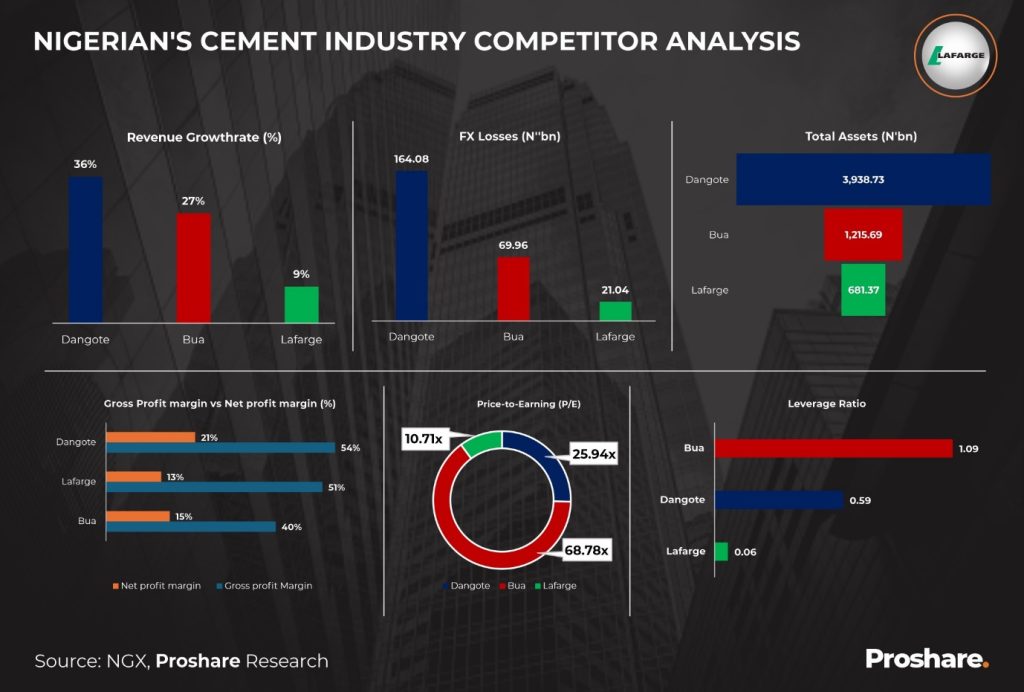
Closing Thoughts
Cement production will remain stable in 2024, but demand will tumble as falling foreign exchange (FX) rates affect domestic prices. Rising local prices will decrease the demand for cement quantities and keep inventory levels higher than ten-year averages. Nevertheless, Dangote Cement and its competitors will retain healthy margins higher than their global rivals.
However, tactically, Dangote seems to have made the smartest move of diversifying output and sales from Nigeria to other faster-growing regions of Africa. The fast-paced expansion of output in East and Central African economies provides a hedge against the FX challenges of the Nigerian market and the fall in real disposable income in Nigeria.
In Nigeria, 2024 will be a difficult year for households and businesses, and this may be reflected in the year-end performances of cement manufacturers. However, with fair stability in the FX market and a mild decline in inflation by year-end (headline inflation was 31.70% in February 2024), the business should see signs of a stronger recovery by Q2 2025. .




